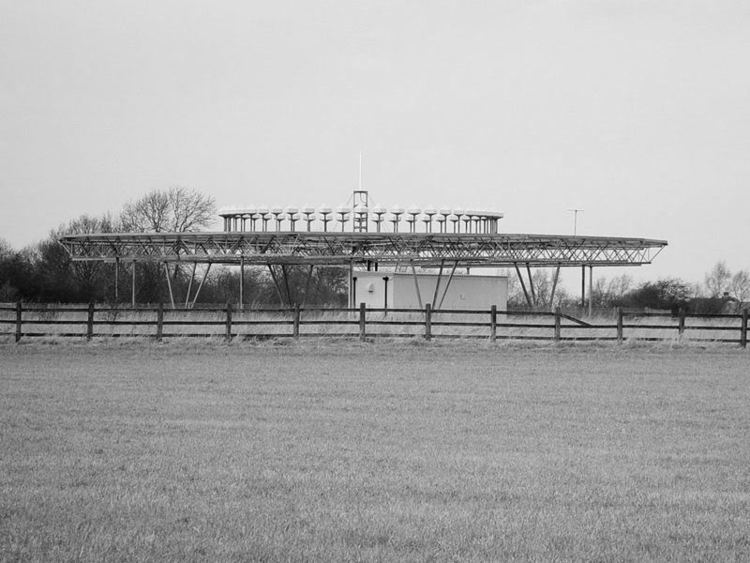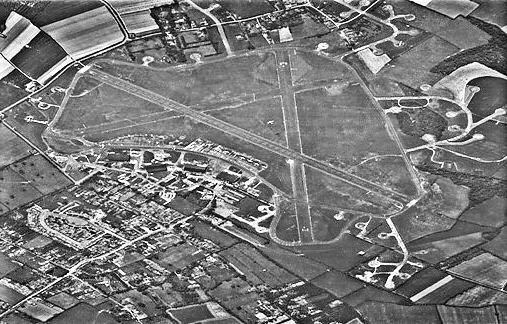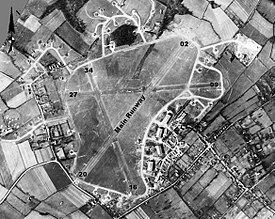In use 1942-1972 (1972) Owner Air Ministry | Elevation 152 m Year built 1941 | |
 | ||
Code BV, BZ (1940s); ZZ (1956) Operator Royal Air ForceUnited States Army Air ForcesUnited States Air Force Controlled by Eighth Air Force (1942-1946)RAF Flying Training Command (1947-1962)Strategic Air Command (1951-1962)RAF Transport Command (1962-1969) Battles/wars Second World WarAir Offensive, EuropeCold War 02/20 1,634 yd (1,494 m) Concrete/tarmac | ||
Royal Air Force Bovingdon or more simply RAF Bovingdon is a former Royal Air Force station located 2.5 miles (4.0 km) south of Hemel Hempstead, Hertfordshire and 2.5 miles (4.0 km) southeast of Berkhamsted, Hertfordshire, England.
Contents
- Royal Air Force use
- United States Army Air Forces use
- 92nd Bombardment Group Heavy
- 11th Combat Crew Replacement Unit
- Postwar uses
- Closure and civilian use
- Film and Television Appearances
- Major units assigned
- References
During the Second World War, the airfield was used by the Royal Air Force (RAF) and the United States Army Air Forces (USAAF) Eighth Air Force. It was assigned USAAF designation Station 112, station code "BV", later changed to "BZ".

Royal Air Force use

Bovingdon was built in 1941/42 as a standard Class A RAF bomber airfield. The main NE/SW runway was 1,634 yards (1,494 m)/4902 feet long and the two secondary runways were 1,433 yd (1,310 m)/4299 feet long each. Over 30 dispersal hardstandings were built.

On 15 June 1942, No. 7 Group, RAF Bomber Command took up residence at Bovingdon. Operational missions were flown in June and July by the RAF until the field was turned over to the USAAF in August.
United States Army Air Forces use
USAAF Station Units assigned to RAF Bovingdon were:
Regular Army Station Units included:

The primary mission of Bovingdon was to support Eighth Air Force Headquarters and the Air Technical Section, both equipped with a variety of aircraft types. General Eisenhower's personal B-17 was housed on the base. During World War II, several film stars were assigned at one time or another to the base, including Clark Gable, James Stewart and William Holden. Among famous wartime visitors were Bob Hope, Frances Langford, Mrs Eleanor Roosevelt, and Glenn Miller.
A unique mission undertaken at Bovingdon was the training of United States journalists to cover the air war over Occupied Europe. A group of military journalists underwent training in February 1943 to fly high-altitude missions in bombers, to shoot the flexible machine guns (although they did not actually fire them in combat), as well as parachute and life support training as aircrew.
The group of journalists flew on a combat mission over Wilhelmshaven, Germany on 26 February 1943 to attack the German Naval submarine pens there. The mission saw heavy losses for the USAAF, and the aircraft of Andy Rooney of the Stars and Stripes was damaged by flak and Robert Post of the New York Times was killed in action when his B-24 exploded. This ended the training of journalists to fly along with Eighth Air Force bomber crews. Other journalists who underwent this training included Walter Cronkite, James Denton Scott, Homer Bigart, William Wade and Gladwin Hill.
92nd Bombardment Group (Heavy)
The first USAAF tenant at Bovingdon was the 92nd Bombardment Group (Heavy), being deployed from Sarasota AAF, Florida. The group was known as "Fame's Favorite Few", and it was assigned to the 4th Combat Wing at RAF Thurleigh. The group tail code was a "Triangle B". Its operational squadrons were:
The 92nd flew a few two combat missions in September and October 1942, then was assigned the role of a Boeing B-17 Flying Fortress Combat Crew Replacement Unit (CCRU). In January 1943, the 92nd was transferred to RAF Alconbury where it was reformed as an operational combat group.
11th Combat Crew Replacement Unit
Although the 92nd Bomb Group departed for Alconbury, the 326th Bomb Squadron of the 92nd remained at Bovingdon to form the core of 11th Combat Crew Replacement Unit. The training was performed on the B-17E aircraft, and most combat crews of 8th Air Force bombing units for the balance of the war received their introduction before moving on to their operational bases. Although based at Bovingdon, the 326th remained under the operational control of the 92nd at Alconbury until May 1943.
In September 1944 the 11th CCRU was disbanded and Bovingdon became the base for the European Air Transport Service (EATS). Many thousands of Americans returned to the States via the air terminal.
Postwar uses
At the end of the war, Bovingdon was returned to RAF control on 15 April 1947. The British Ministry of Civil Aviation obtained the airfield for civilian airline use. On 15 September 1949, Bovingdon was the start point for a successful record air speed attempt by a de Havilland Hornet to and from Gibraltar.
Because of its elevation, Bovingdon was often clear when Heathrow Airport and RAF Northolt were fog-bound and, during the winter months especially, Bovingdon was used by British European Airways (BEA). British Overseas Airways Corporation (BOAC) used Bovingdon as a maintenance facility and numerous other independent aircraft operators used the former technical site during the postwar years.
During the 1950s both civilian and military organizations used Bovingdon. The proximity of the USAF Third Air Force Headquarters at RAF South Ruislip and HQ RAF Fighter Command at Bentley Priory made Bovingdon the ideal location for service aircraft.
The USAF returned to Bovingdon on 25 May 1951, with the establishment of the 7531st Air Base Squadron. Douglas C-47 Skytrains were assigned to the unit, however many transitory USAF planes used the airfield routinely. In addition, the RAF operated the Fighter Command Communications Squadron on the base. In 1962, the USAF departed from Bovingdon. During the 60s, RAF Transport Command (Southern Communications Squadron) operated Anson, Devon, Pembroke and latterly Basset aircraft from Bovingdon. In the 1960s the base was home to the last flight of Anson Mk 21 aircraft, descended from a World War II design.
During the winters of 1966/7 and 1967/8, Air Cadet No. 613 Gliding School operated from Bovingdon at a time when RAF Halton was waterlogged and unusable. During this period Staff Cadet Flt Sgt Chris Rollings held the record for driving a Series 1 Land Rover around the perimeter track. The runner up was Staff Cadet Sgt V. Luck. These activities were carried out whilst all officers were at lunch and they remained blissfully unaware. The exact times achieved are lost in the mists of time.
The Air Training Corps 617 Gliding School operated from Bovingdon between 1968 and 1970, the last flight by a military aircraft being Kirby Cadet Mk.3 glider XN246 on 25 oct 1970. The school had moved from RAF Hendon in 1968 but moved on to RAF Manston in 1971. In 1968 the airfield was used to store and dispose of several aircraft used in the making of the film "Battle of Britain".
Closure and civilian use
In 1968, the Ministry of Defence (MOD) announced that Bovingdon would be closed for budgetary reasons, and in 1972 the airfield was shut down, although since World War II to present day, the runway, 650m long x 49m wide on Berry Farm has continuously been used for light aircraft activities. Berry Farm is owned separately and is unconnected to the part of the original airfield where the land has been utilized for various other uses including the market. In 2012 Dacorum Borough Council confirmed the Berry Farm stretch of runway 08/26 remains a legal active airfield for light aircraft operation.
In the early 1980s, flying returned to the airfield in the form first of hang-glider tow-launching (using a truck-mounted pay-out winch) and then microlight aircraft, mainly of the 'Trike/hang-glider' type. Some Bovingdonians complained on the grounds of "noise" and "danger". After local inquiry, the Ombudsman narrowly decided against allowing flying to continue. At that time the combined control tower and fire-tender garage were in 'reasonable structural condition' but deliberately damaged a few years later by earthmoving equipment, thereafter making restoration highly unlikely. The remains of the control tower were demolished in August, 2010.
An area of the former technical site was transferred to HM Prison Service for use as a prison, called 'The Mount' which opened in 1987.
The airfield site still houses a VOR navigational beacon, code BNN. The airspace above the airfield and nearby Chesham is known as the Bovingdon stack and is a holding area for aircraft approaching Heathrow Airport, 32 kilometres (20 mi) to the south. Aircraft are requested to join the hold, typically at an altitude of 14000–16000 feet, and then fly a 'race-track' pattern around the Bovingdon VOR beacon, separated at intervals of 1000 feet from other aircraft. Each aircraft is then instructed to descend to a lower available altitude as the lowest aircraft leaves the hold to make its final approach to Heathrow. At busy times, therefore, there may be up to 10 aircraft holding at the available 1000 foot separations between 7000 feet and 16000 feet and these may be seen circling overhead on a clear day.
The remainder of the airfield site is used for a regular Saturday market and there was also a permanent circuit for banger racing which closed in September 2008. The main runway and taxiways which are still intact though in a poor state of repair, but are also used for other events such as Autojumbles and Classic Car Shows. Alongside a runway is a Delta Force Paintballing Facility. The ruins of the control tower also remain.
The airfield has also been used for concrete-crushing, again creating concern in Bovingdon Parish Council, who have tried to stop it, citing 'noise'.
Film and Television Appearances
In the 1960s, Bovingdon was used in the production of four World War II films, The War Lover (1962); 633 Squadron (1964) Battle of Britain (1969) and Mosquito Squadron (1969). Although flying ceased at the airfield in 1969, it was also used to film parts of the flying car scenes in the James Bond film 'The Man With the Golden Gun' starring Roger Moore, when the palm trees fold down as it takes off as well as some flying scenes for the film Hanover Street which were shot there in 1978. The site was also used in the 2016 Star Wars spinoff film Rogue One, representing the planet Scarif.
On television it served as the location for at least one black and white episode of The Avengers "The Hour That Never Was", starring Patrick Macnee and Diana Rigg featuring Gerald Harper and Roy Kinnear [1] as well as the 1980 Blake's 7 episode The Harvest of Kairos as the surface of the planet Kairos.[2]. An airstrip at the airfield is also reputed to have been used in the opening credits of the 1967 television series The Prisoner in which Patrick McGoohan is seen driving a Lotus Super Seven car past the camera at speed. It has continued to be used in various TV shows up to the present day.
